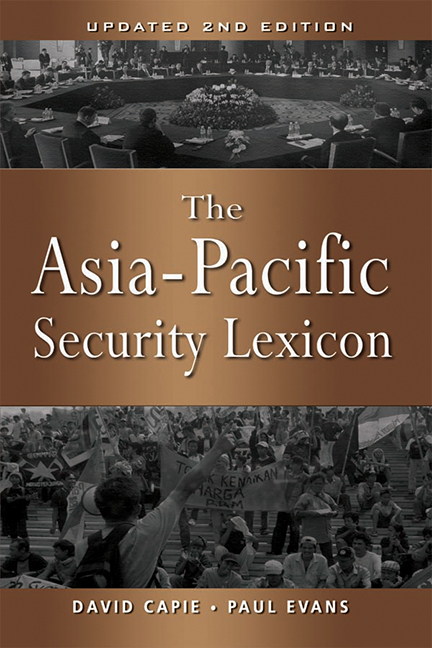Book contents
- Frontmatter
- Contents
- Abbreviations
- Introduction to the Second Edition
- Ad Hoc Multilateralism
- A la Carte Multilateralism
- The “ASEAN Way”
- Balance of Power
- Bilateralism
- Coalition of the Willing
- Coercive Diplomacy
- Collective Defence
- Collective Security
- Common Security
- Comprehensive Security
- Concert of Powers
- Concerted Unilateralism
- Confidence-Building Measures
- Confidence- and Security-Building Measures
- Constructive Intervention
- Cooperative Security
- Engagement
- Flexible Consensus
- Human Security
- Humanitarian Intervention
- Middle Power
- Multilateralism
- Mutual Security
- New Security Approach
- Non-Traditional Security
- Open Regionalism
- Peaceful Rise
- Pre-emption and Preventive War
- Preventive Diplomacy
- Security Community
- Terrorism
- Track One
- Track One-and-a-Half
- Track Two
- Track Three
- Transparency
- Trust-Building Measures
- About the Authors
Constructive Intervention
Published online by Cambridge University Press: 21 October 2015
- Frontmatter
- Contents
- Abbreviations
- Introduction to the Second Edition
- Ad Hoc Multilateralism
- A la Carte Multilateralism
- The “ASEAN Way”
- Balance of Power
- Bilateralism
- Coalition of the Willing
- Coercive Diplomacy
- Collective Defence
- Collective Security
- Common Security
- Comprehensive Security
- Concert of Powers
- Concerted Unilateralism
- Confidence-Building Measures
- Confidence- and Security-Building Measures
- Constructive Intervention
- Cooperative Security
- Engagement
- Flexible Consensus
- Human Security
- Humanitarian Intervention
- Middle Power
- Multilateralism
- Mutual Security
- New Security Approach
- Non-Traditional Security
- Open Regionalism
- Peaceful Rise
- Pre-emption and Preventive War
- Preventive Diplomacy
- Security Community
- Terrorism
- Track One
- Track One-and-a-Half
- Track Two
- Track Three
- Transparency
- Trust-Building Measures
- About the Authors
Summary
Following the violent disintegration of the coalition government in Cambodia in July 1997, the Deputy Prime Minister of Malaysia Anwar Ibrahim called on the Association of Southeast Asian Nations (ASEAN) to play a more proactive role in solving the region's security problems. In an article published in Newsweek, he said ASEAN should consider initiating what he called “constructive interventions” and “constructive involvement” before simmering regional problems erupt into full-blown crises. He gave as examples of constructive involvement “among other things, direct assistance to firm up electoral processes, an increased commitment to legal and administrative reforms, the development of human capital and the general strengthening of civil society and the rule of law”. He added that he thought ASEAN was already moving towards such an approach, citing its willingness to ensure the conduct of free and fair elections in Cambodia and the engagement of the State Law and Order Restoration Council (SLORC) regime in Myanmar. Anwar's comments prompted a great deal of debate and discussion in Southeast Asia, in particular about how to reconcile constructive intervention with ASEAN's long-held principle of non-interference or non-intervention in the internal affairs of member states.
While the Newsweek article fuelled considerable debate, the term constructive intervention is not a wholly new one. In an article published in the New York Times in 1983, the former U.S. ambassador to the Philippines, William H. Sullivan, called for President Ronald Reagan to use a scheduled visit to Manila as “an opportunity for constructive intervention” to facilitate a peaceful and democratic transition in Philippines politics. Constructive intervention also has something in common with ideas such as “humanitarian intervention”, “peacebuilding”, and “constructive engagement” that have a more established pedigree in international politics. One report described constructive intervention as a “compromise between constructive engagement and sanctions.” In its most recent manifestation, the term seems to have its origins with academics and policy analysts connected to the track two security and strategic studies community in Southeast Asia.
- Type
- Chapter
- Information
- The Asia-Pacific Security Lexicon (Upated 2nd Edition) , pp. 97 - 104Publisher: ISEAS–Yusof Ishak InstitutePrint publication year: 2007



